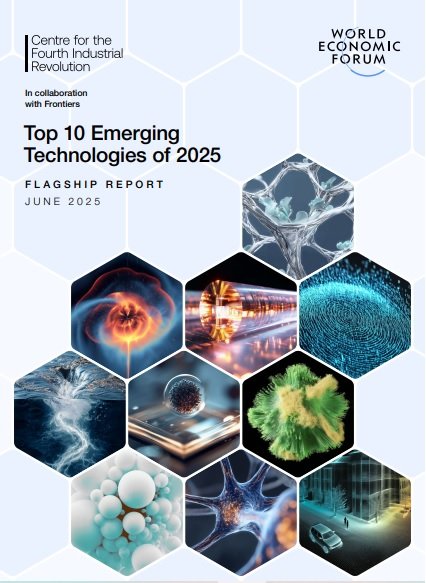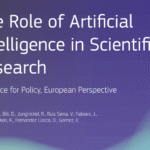
As cities become more connected, collaborative sensing allows vehicles, traffic systems, and emergency services to coordinate in real-time, improving safety and easing congestion. This is just one of the World Economic Forum’s Top 10 Emerging Technologies of 2025 that is expected to have a real-world impact within three to five years and address urgent global challenges.
In collaboration with Frontiers, the report highlights cutting-edge technologies at their inflection point, where scientific progress meets real-world application. Chosen for their novelty, maturity, and potential to deliver significant social benefit, they reflect advances in both innovation and resilience. This year’s group reveals four key trends: trust and safety in a connected world, next-generation biotechnologies for health, redesigning industrial sustainability, and the integration of energy and materials.
“Scientific and technological breakthroughs are advancing rapidly, even as the global environment for innovation becomes more complex,” said Jeremy Jurgens, Managing Director of the World Economic Forum. “The research provides top global leaders with a clear view of which technologies are approaching maturity, how they could solve the world’s pressing problems, and what is required to bring them to scale responsibly.”
This year’s list builds on previous themes, reaffirming health, sustainability, and urban resilience as top priorities. Technologies such as collaborative sensing, autonomous biochemical sensing, and green nitrogen fixation demonstrate continuous innovation in these fields where urgent challenges persist. They also signal a growing momentum to develop scalable solutions to chronic diseases, environmental impact, and infrastructure strain.
This year’s edition highlights a trend towards technological convergence. For example, structural battery composites combine energy with storage design, while engineered living therapeutics merge synthetic biology and precision medicine. Such integration signals a shift from standalone innovations to more integrated, systems-based solutions that reshape what is possible.
“The path from cutting-edge research to tangible social progress depends on transparency, collaboration, and open science,” said Frederick Fenter, chief executive editor of Frontiers. “Together with the World Economic Forum, we have once again provided reliable, evidence-based knowledge on the emerging technologies that will shape a better future for all.”
The fusion of energy and materials: redefining efficiency
The demand for clean and efficient energy is driving a new era of smart materials that integrate energy storage into their own structure.
Structural battery composites
Imagine the body of an electric car that not only protects passengers but also functions as the vehicle’s battery. That is the promise of structural battery composites (SBCs), which combine lightweight, high-strength materials, such as carbon fiber, with the ability to store energy. This technology eliminates the dead weight of traditional battery casings, promising lighter vehicles with greater autonomy and lower manufacturing costs. Airbus is already experimenting with SBCs for aircraft, opening the door to more sustainable transport.
Osmotic power systems
Known as “salt power,” this technology generates clean and constant electricity from the salinity difference between two sources of water, such as a river meeting the sea. Unlike solar or wind power, its production does not fluctuate with the weather, providing a stable source of energy. Recent advances in semipermeable membranes are overcoming the barriers that have hindered its adoption in the past, with commercial projects already being installed in places like France and Denmark.
Advanced nuclear technologies
Faced with the growing energy demand driven by AI and the electrification of transport, nuclear energy is re-emerging with safer, more efficient, and more economical designs. Small modular reactors (SMRs), mass-produced and transported to the site, promise to eliminate the high costs and long design cycles of traditional plants. Countries like China and Russia already have operational plants, while the West is advancing rapidly, positioning advanced nuclear energy as a key pillar for a carbon-free future.
Biotechnology at the service of health: A new era of treatments
Biological interventions are moving from traditional pharmaceutical approaches to living and dynamic solutions that monitor and treat diseases from within the body.
Engineered living therapeutics
This approach uses microbes, such as bacteria or yeast, that are genetically modified to function as “living factories” inside the body, producing drugs in a controlled and sustained manner. They could respond to disease signals to release a therapy just when it is needed, eliminating up to 70% of the production costs of biopharmaceuticals and the need for frequent injections. Clinical trials are already underway to treat everything from diabetic ulcers to cancer.
GLP-1 for neurodegenerative diseases
GLP-1 drugs, known for their use in treating type 2 diabetes and obesity, are showing unexpected potential to treat diseases such as Alzheimer’s and Parkinson’s. Early research suggests that these drugs can cross the blood-brain barrier, reducing brain inflammation and promoting neuron longevity. Although more clinical trials are needed, their success could transform the treatment of diseases that affect more than 55 million people worldwide.
Autonomous biochemical sensors
These devices continuously and remotely monitor biochemical parameters, such as disease markers in patients or chemical changes in soil and water. Unlike single-use tests (such as COVID-19 tests), these sensors operate independently, are self-powered, and send data in real-time. The continuous glucose monitor is the most successful example to date, but sensors are already being developed to track female hormones or detect toxins in food with unprecedented sensitivity.
Towards a sustainable industry: Reinventing key processes
Sustainability is no longer an option, and innovation is focused on redesigning fundamental industrial processes to dramatically reduce their carbon footprint.
Green nitrogen fixation
The production of ammonia for fertilizers, essential for 50% of the world’s food production, consumes 2% of global energy. The traditional process (Haber-Bosch) requires high pressures and temperatures, generating enormous amounts of CO₂. Green nitrogen fixation uses biology- or electrochemistry-based approaches to produce ammonia using renewable energy, at ambient temperature and pressure. This would not only decarbonize agriculture but also allow for decentralized and local production.
Nanozymes
These are laboratory-produced nanomaterials that mimic the function of natural enzymes, the catalysts of life. However, unlike enzymes, nanozymes are cheaper to produce, more stable in extreme conditions, and more versatile. Their applications are vast: from the targeted delivery of anti-cancer drugs to water purification and the detection of contaminants in food. Their market is projected to grow from $5.13 billion in 2024 to $57.95 billion in 2034.
Foundations of trust for a connected future
As AI and sensors become ubiquitous, ensuring the authenticity and security of information is more crucial than ever.
Collaborative sensors
The sensors distributed in our homes, vehicles, and cities are connecting to each other and integrating with AI systems to create a collective intelligence. An autonomous car will not only “see” with its own sensors, but it will also know, thanks to a connected traffic light, that another vehicle is approaching at high speed at a blind intersection. This technology promises to transform urban mobility, natural resource management, and emergency response.
Generative watermarking
In a world flooded with AI-generated content, differentiating the real from the synthetic is one of the biggest challenges. Generative watermarking embeds invisible markers in AI texts, images, and videos to verify their authenticity and trace their origin. Companies like Google and Meta are already implementing these digital “fingerprints” to combat misinformation and protect intellectual property. Although it is not a foolproof solution, its adoption at an industrial level is key to building a responsible digital ecosystem.
The report describes what is needed to bring these technologies to scale: investment, infrastructure, standards, and responsible governance, and calls on companies, governments, and the scientific community to collaborate to ensure that their development serves the public good. The technologies highlighted are not isolated innovations, but rather signals of broader systemic transformations.
For innovators, the message is clear: the future is not predicted, it is built. Understanding these technologies is the first step to reimagining products, services, and business models. The real challenge, and the greatest opportunity, lies in interdisciplinary collaboration and the will to turn these promising signals into the foundations of a more resilient, sustainable, and equitable world.
Reference (open access)
World Economic Forum. (2025, junio). Top 10 Emerging Technologies of 2025. World Economic Forum. 44 p.
Editor and founder of “Innovar o Morir” (‘Innovate or Die’). Milthon holds a Master’s degree in Science and Innovation Management from the Polytechnic University of Valencia, with postgraduate diplomas in Business Innovation (UPV) and Market-Oriented Innovation Management (UPCH-Universitat Leipzig). He has practical experience in innovation management, having led the Fisheries Innovation Unit of the National Program for Innovation in Fisheries and Aquaculture (PNIPA) and worked as a consultant on open innovation diagnostics and technology watch. He firmly believes in the power of innovation and creativity as drivers of change and development.





